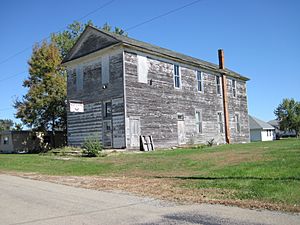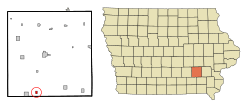Martinsburg, Iowa facts for kids
Quick facts for kids
Martinsburg, Iowa
|
|
|---|---|

Abandoned Mason's lodge in Martinsburg
|
|

Location of Martinsburg, Iowa
|
|
| Country | |
| State | |
| County | Keokuk |
| Area | |
| • Total | 0.37 sq mi (0.97 km2) |
| • Land | 0.37 sq mi (0.97 km2) |
| • Water | 0.00 sq mi (0.00 km2) |
| Elevation | 804 ft (245 m) |
| Population
(2020)
|
|
| • Total | 110 |
| • Density | 294.12/sq mi (113.48/km2) |
| Time zone | UTC-6 (Central (CST)) |
| • Summer (DST) | UTC-5 (CDT) |
| ZIP code |
52568
|
| Area code(s) | 319 |
| FIPS code | 19-49935 |
| GNIS feature ID | 2395031 |
Martinsburg is a small city located in Keokuk County, Iowa, United States. In 2020, about 110 people lived there. Today, Martinsburg has a few local businesses, including an auto service shop and a gas station with a convenience store.
Contents
History of Martinsburg
Martinsburg started as a small community in 1861. It was mainly a row of houses along one side of the road. By 1874, the town had grown. It had two general stores where people could buy everyday items. There was also a hotel and a Presbyterian church.
Early Businesses and Trades
In those early days, Martinsburg had two doctors. There was also a wagonmaker who built and repaired wagons. This wagonmaker also had a vineyard, which is a place where grapes are grown. People who owned a sawmill and a grain mill nearby also lived in the town.
Railroads Arrive in Town
The first train line, the Burlington and Western Railway, came to Martinsburg in late 1882. This was a narrow gauge line, meaning its tracks were closer together than usual. In 1902, these tracks were made wider to become standard gauge. The Chicago, Burlington and Quincy company then took over the line.
Around the same time, the Minneapolis and St. Louis also built tracks to Martinsburg. The two train lines ran side-by-side west of town. They then split off as they went east. Later, in 1934, the Chicago, Burlington and Quincy tracks were sold to the Minneapolis and St. Louis company.
Town Growth and Industries
By 1887, Martinsburg had expanded with five new areas for homes. It gained a second church and another hotel. The town also got its own post office. Besides the two train stations, there was a brickworks that mostly made drainage tile. A creamery (for dairy products), a gristmill (for grinding grain), and a grain elevator (for storing grain) were also important businesses.
Recent Events
In 2023, Martinsburg was hit by a strong tornado. This tornado was rated EF-3, which means it caused significant damage.
Geography of Martinsburg
Martinsburg covers a total area of about 0.97 square kilometers (0.38 square miles). All of this area is land, meaning there are no large bodies of water like lakes or rivers within the city limits.
Population Changes Over Time
| Historical populations | ||
|---|---|---|
| Year | Pop. | ±% |
| 1880 | 154 | — |
| 1890 | 322 | +109.1% |
| 1900 | 332 | +3.1% |
| 1910 | 285 | −14.2% |
| 1920 | 278 | −2.5% |
| 1930 | 223 | −19.8% |
| 1940 | 218 | −2.2% |
| 1950 | 219 | +0.5% |
| 1960 | 172 | −21.5% |
| 1970 | 140 | −18.6% |
| 1980 | 174 | +24.3% |
| 1990 | 157 | −9.8% |
| 2000 | 126 | −19.7% |
| 2010 | 112 | −11.1% |
| 2020 | 110 | −1.8% |
| Source: and Iowa Data Center Source: |
||
The population of Martinsburg has changed quite a bit over the years. In 1880, there were 154 people living there. The population grew to over 300 by 1900. Since then, the number of people living in Martinsburg has slowly decreased. In 2020, the city had a population of 110 people.
Education in Martinsburg
Students in Martinsburg attend schools within the Pekin Community School District.
See also
 In Spanish: Martinsburg (Iowa) para niños
In Spanish: Martinsburg (Iowa) para niños

